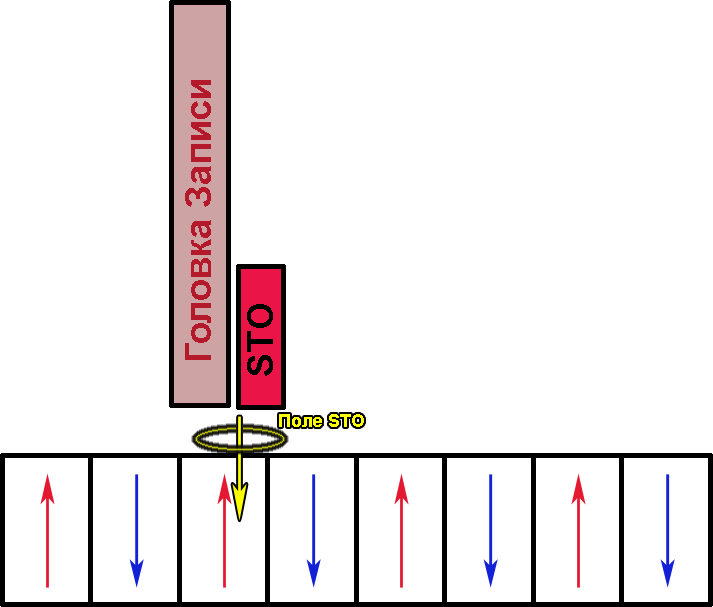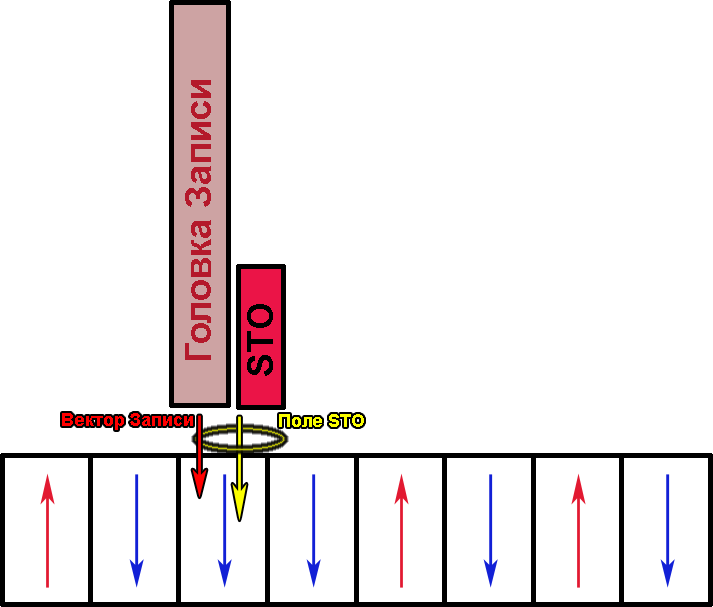How MAMR works in HDD
Already in 2019, new hard drives with MAMR technology should be released. This technology will increase the recording density up to 4Tbit per square inch, which in theory will allow you to create a 40TB HDD.
Since the creation of the HDD, the recording density of drives has doubled every year and continued until 2010, when the increase in recording density began to slow down. This is due to the fact that perpendicular magnetic recording (PMR) has begun to approach its theoretical limit of 1TB per square inch.
The limitation for PMR is associated with the influence of the superparamagnetic effect, when a decrease in the physical dimensions of magnetic domains (one magnetic domain encodes 1 bit of information) in a ferromagnetic substance with a certain coercive force can lead to an arbitrary change in the magnetic moment of such domains. In other words, with sufficiently small magnetic domains, such a disk can arbitrarily lose information.
There are two ways to defeat the superparamagnetic effect in the HDD:
At one point, the engineers noticed that if a special field of a certain frequency is applied to a ferromagnetic substance, then much less energy can be spent to change the magnetic moment of the domain.
So the MAMR technology was born. MAMR stands for Microwave-Assisted Magnetic Recording, or Microwave Magnetic Recording.
MAMR works very interesting.
The magnetic moment in ferromagnets is provided by the intrinsic spins of elementary particles in the atoms of a substance. When the spins of the particles inside the magnetic domain are “directed” to one side, a magnetic moment of the domain arises, which can be read using the reading head. The magnetic moment can be in one of two directed states, due to this, information is recorded.
An important part of MAMR is the Spin Torque Oscillator (STO), or “spin spin generator”. STO itself is located in close proximity to the recording head. When current is applied to STO, a circular electromagnetic field field is generated with a frequency of 20-40 GHz due to polarization of electron spins.
Under the influence of such a field, a resonance occurs in the ferromagnet used for MAMR, which leads to the precession of the magnetic moments of the domains in this field. In fact, the magnetic moment deviates from its axis and to change its direction (flip) the recording head needs significantly less energy.
Visual work of MAMR is presented in the pictures.
Drive includes STO

Under the influence of the STO field, the magnetic moment begins a precession and deviates to the side

The drive delivers a current pulse through the recording head, which causes a change in the direction of the magnetic moment in the domain.

Using MAMR technology allows one to take ferromagnetic substances with a greater coercive force, which means that it is possible to reduce the size of magnetic domains without fear of causing a superparamagnetic effect. The STO generator helps to reduce the size of the recording head (by reducing the necessary energy in the recording pulse), which makes it possible to record information on smaller magnetic domains, and therefore increases the recording density.
The problem of perpendicular magnetic recording
Since the creation of the HDD, the recording density of drives has doubled every year and continued until 2010, when the increase in recording density began to slow down. This is due to the fact that perpendicular magnetic recording (PMR) has begun to approach its theoretical limit of 1TB per square inch.
The limitation for PMR is associated with the influence of the superparamagnetic effect, when a decrease in the physical dimensions of magnetic domains (one magnetic domain encodes 1 bit of information) in a ferromagnetic substance with a certain coercive force can lead to an arbitrary change in the magnetic moment of such domains. In other words, with sufficiently small magnetic domains, such a disk can arbitrarily lose information.
There are two ways to defeat the superparamagnetic effect in the HDD:
- You can increase the size of the magnetic domain (i.e., the physical size of the recording head), but this will lead to a decrease in the recording density, and hence to a decrease in the total storage volume
- You can use a magnetic alloy with a greater coercive force, but then you need to increase the recording energy, which means an increase in the size of the recording head, and therefore an increase in magnetic domains and a decrease in recording density. So, at least, it was supposed.
MAMR as a solution to the problem
At one point, the engineers noticed that if a special field of a certain frequency is applied to a ferromagnetic substance, then much less energy can be spent to change the magnetic moment of the domain.
So the MAMR technology was born. MAMR stands for Microwave-Assisted Magnetic Recording, or Microwave Magnetic Recording.
MAMR works very interesting.
The magnetic moment in ferromagnets is provided by the intrinsic spins of elementary particles in the atoms of a substance. When the spins of the particles inside the magnetic domain are “directed” to one side, a magnetic moment of the domain arises, which can be read using the reading head. The magnetic moment can be in one of two directed states, due to this, information is recorded.
An important part of MAMR is the Spin Torque Oscillator (STO), or “spin spin generator”. STO itself is located in close proximity to the recording head. When current is applied to STO, a circular electromagnetic field field is generated with a frequency of 20-40 GHz due to polarization of electron spins.
Under the influence of such a field, a resonance occurs in the ferromagnet used for MAMR, which leads to the precession of the magnetic moments of the domains in this field. In fact, the magnetic moment deviates from its axis and to change its direction (flip) the recording head needs significantly less energy.
Visual work of MAMR is presented in the pictures.
Drive includes STO

Under the influence of the STO field, the magnetic moment begins a precession and deviates to the side

The drive delivers a current pulse through the recording head, which causes a change in the direction of the magnetic moment in the domain.

Using MAMR technology allows one to take ferromagnetic substances with a greater coercive force, which means that it is possible to reduce the size of magnetic domains without fear of causing a superparamagnetic effect. The STO generator helps to reduce the size of the recording head (by reducing the necessary energy in the recording pulse), which makes it possible to record information on smaller magnetic domains, and therefore increases the recording density.
All Articles